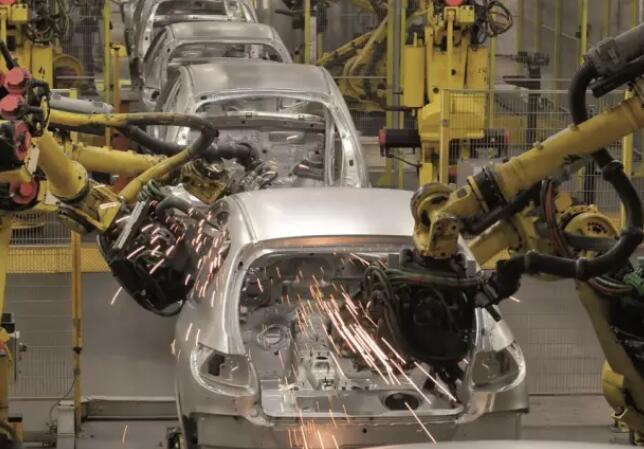Connectors are used to transmit power and signals between the cabinet and the robot . With suitable connection technology, connection interfaces can be inserted into the robot head, which connect the robot to the internal factory network via the communication controller.
The space on the production line is getting more and more compact, and the robot is getting smaller and smaller, especially when the robot works in a high temperature environment and has special requirements for connection technology in harsh environments, the role of the connector appears more important. According to different needs, connectors are mainly used in the following situations of industrial robots:
1. High integration Degree interface saves space for robots
In developing new application areas, such as on assembly lines, robot manufacturers face two major challenges:
robots need more and more Sensing sensors, they must become smaller and more flexible for more complex assembly operations. Han® industrial connectors can support the development of such robotic systems by miniaturizing and ensuring shielded data transmission.
High Density Interface Connectors with Mixed Configurations
In addition to electrical signals, modular connectors can transmit compressed air, light waves and high currents. As a "hybrid" interface, they accomplish the tasks of several small individual interfaces. In order to make optimal use of the space within the connector, HARTING continuously increases the interface density of the Han-Modular® modular connectors. For example, Han D® / Han DD® high pin count connector ferrules, with up to 216 pins, transmit power or signals up to 10A / 150 V.
The second example is, Han® high density module: under full load, there are 25 pins in the module, which can transmit 4A/50V signal. Other Han® modules with higher contact densities are also in development.
Integrated housing for robots
For example, Han® 72 DD, often used in industrial ovens, in widths of 78 or 85 mm Case, Han® 72 DD ferrule provides 72 pins, which can transmit both signal and power. In addition, HARTING recently developed the Han® K 32/55 connector, which has 32 power or signal pins (10A / 250 V) in addition to 55 signal pins (4A / 50 V). This "hybrid" connector does not require more space than Han® 72 DD. In order to reduce cost and save space, the robot needs to reduce the number of interfaces as much as possible. According to the principle of "two-in-one", such an interface placed in a 10B standard shell is enough to meet the power and signal control requirements of an industrial robot.
Reduce the height of the robot interface
HARTING's newly developed Han® HP Direct product reduces the height of robot interfaces. Han® HP Direct replaces the bulkhead mounted housing with a flange to which the housing can be fastened. A connection side, usually the connection side with the male connector, is set into the foot of the robot, which reduces the overall height.
Han® 10 HP Direct offers more space: the shell is almost 2 cm higher than the high-structure version of the Han® B. Therefore, the new Han® K 32/55 with 87 contacts is easy to handle and can be inserted comfortably into the housing, including the cable. In addition to this, the increased space is due to the use of set screws. For users who do not want to use a tool-less locking system, Han-Modular® connectors with the highest density - namely Han® DD Quad modules - remain the best solution for robotic interfaces.
2. Miniaturization to the last millimeter
Valve terminals are An integral part of pneumatic automation systems. Today's devices typically use fieldbuses for communication, allowing various electrical functions to be integrated. In addition to considering flow rate, one of the key product features is the need for a compact design. Festo, the inventor of the valve terminal, is today one of the world's leading suppliers of pneumatic and electrical automation technology. Using HARTING's har-flex® PCB connector series, Festo has developed a new VTUG valve terminal with enhanced flow rates and a more compact design.
Through its miniaturized 1.27 pitch compact design, the connector can save more required space when designing equipment. Of particular importance to Festo is that HARTING's 30-pin pinout provides the company with a precise pin count. The entire product family can be supplied with any even number of pins between 6-100, which is standard for HARTING customers. Despite increasing miniaturization, connectors are characterized by a high degree of robustness. In addition to the reinforced wall thickness of the insert, the additional side-mounted SMT fixation ("press-in") always guarantees a secure connection to the PCB, making the connector ideal for use in industrial electronics.
Highest flexibility in device design har-flex® connectors are available as straight and angled PCB connections and IDC cable assembly connections.
3, Simultaneous transmission of data, signal, power
Reliable transmission of signals and power in all performance ranges is one of the fundamental requirements for industrial applications. The new HARTING PushPull signal connectors consistently meet these requirements in one unified connector system.
Features
According to the guidelines of the PROFIBUS user organization and AIDA (Automation Initiative of German Automobile Manufacturers), the Han® PushPull Variant 14 is a The preferred connector for automation systems.
In connection technology, handling applications, sensors or imaging components, there are a wide range of applications, especially the application of industrial robots in highly automated automotive welding and assembly lines. Although all defined standards for the data area require separate signal and data communication processes. In addition to power supply and standard communications, the transmission of analog, digital, bus and low-voltage signals must be guaranteed.

HARTING PushPull delivers 5A rated current across 10 contacts with conductor cross-sections up to 0.75 mm². To ensure electromagnetic immunity, the contact inserts are fully shielded as RJ45 data connectors, and shielded cables can be connected. The locking function of PushPull ensures a reliable connection of the connector. Proper locking is indicated by a "click" when inserted.
PushPull signal connectors can also handle mixed applications. For example, a portion of the contact surface can be used to transmit power, while other contacts can be used for communication. PushPull signal connectors are used in PushPull Variant 14 and Variant 4 series as defined by IEC 61076-6-107. PushPull signal connectors are defined in accordance with IEC 61076-6-107 and are available in PushPull Variant 14 and Variant 4 sizes.
Simple wire connections on site are key. PushPull signal connectors are delivered pre-assembled, minimizing the number of parts the user separates. Connectors are installed by inserting individual crimp pins into pre-assembled insulating inserts. Simply press down on the insulating insert to lock it into its final position and hold the crimp pin in place. The user can easily correct any errors after installing the insulating insert. Using factory pre-fabricated cable assemblies of different lengths reduces on-site machining efforts.
4. Powering the laser cutting system
laser cutting system It does offer high precision in modern manufacturing. For power to these systems and for control purposes, designers of laser systems trust reliable HARTING connectors. The use of lasers is becoming more and more important in machine building, especially in the automotive industry. HARTING connectors contribute to the working precision and reliability of these laser systems, and in addition, they offer the possibility to quickly replace system components in the event of a failure.
Rugged connectors and housings protect the inserts from dirt, moisture and welding sparks, which are fairly common in the manufacturing process. For example, Han® 24E ferrules with caged spring connections are just right for this current transfer need. Power transfer can be achieved with 24 contacts (rated current: 16A; 500V) within one housing through this connector. Cage shrapnel connections are beneficial during machine assembly and provide very high vibration stability.
Sensitive signals required for laser system control can be transmitted through the use of Han-ModularQuintax® ferrules, which have very good shielding attenuation to protect these sensitive signals from interference from any existing electromagnetic interference, thereby helping to ensure the reliability of the entire laser system.
Robots effectively and reliably connect and communicate with the system through these industrial connectors.

 16675588672 (Manager Liu)
16675588672 (Manager Liu)
 CH
CH





 Customer service
Customer service